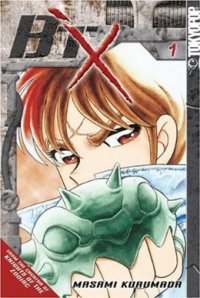RIGHT TURN ONLY!!
Not Love But Delicious Ninjas
by Carlo Santos,

Somehow, in my excitement over the English release of K-ON!, I forgot to bring up this photo last time:

Ladies and gentlemen, the moe-est street intersection in America.
ITSUWARIBITO

Vol. 1
(by Yuuki Iinuma, Viz Media, $9.99)
FROM THE BACK COVER:
"Utsuho's truthfulness as a child resulted in an enormous catastrophe, and he decided to lie from that day forward. Raised in a village of orphans by a monk, Utsuho is an unrepentant troublemaker. The monk eventually inspires him to help people, but there's no way Utsuho's going to lead an honest life! Instead, he's going to use his talents for mischief and deception for good!"
EVIDENCE FOR:
At first glance, it seems that Itsuwaribito's positive qualities consist of just the usual things that make Shonen Sunday titles appealing: the well-timed bursts of action, the vaguely traditionalist/historical setting, the spiky, stylish character designs, and the constant ebb and flow of adventure. But there is much more than just the eye-candy aspect of seeing Utsuho kicking butt with his agile moves and confounding smoke bombs. As a trickster character in the lead role (rather than a musclebound brute or screaming middle schooler), Utsuho is at his best when playing mind games with his adversaries. Few things are as satisfying as seeing him outwit a crook in a lying contest, or using classic disguise techniques to infiltrate a band of masked bandits. Then comes the moral grayness of Utsuho's quest, in which he justifies telling "good lies" in order to protect those who cannot be saved by pure honesty. It's an intriguing depature from the moral absolutism that usually comes with shounen adventure series; sometimes a few minor wrongs do make a right. See, told you it was all about intriguing mind games—both logical and ethical.
EVIDENCE AGAINST:
While Itsuwaribito certainly has all the classic elements of a rollicking, youthful adventure, those elements are also why it quickly runs out of creative steam. Oh, sure, Utsuho cooks up some clever tricks, but how many times is he going to pull a fast one simply by saying "Just lying"? No one likes to see a gimmick get old when it's only the first volume, and there's got to be more to Utsuho's tactics than just saying the opposite of what he means. The overall structure of these early chapters is also nothing to get excited about, with the standard origin story (schmaltzy dramatic death included) and villains-of-the-week popping up at regular intervals. The wise old mentor, the plucky animal sidekick, the distressed damsel whose brother needs rescuing—these highly typical genre elements play a big role in this volume, and make it hard to see the series as little more than a copycat effort with a slightly unusual protagonist. The sparse backgrounds also reveal a missed opportunity, where the pastoral village setting could have helped add an extra dimension to the story.
FINAL VERDICT:
Utsuho's penchant for trickery is easily the best thing about this series—but if he only ever plans to use it for outwitting bad guys week after week, then it's going to be stuck on C for a while.
NEGIMA!

Vol. 28
(by Ken Akamatsu, Del Rey, $10.99)
FROM THE BACK COVER:
"Now that the tournament is over, Negi wants to find his missing students and take them home. But first, he's confronted by a sinister man who claims to know the answers to all of Negi's questions. He promises to share those answers—but only if Negi will join his cause."
EVIDENCE FOR:
Fate Averruncus? Who's he? Even though the Magical World is still faces the threat of the white-haired wizard's global domination plan, this volume of Negima! throws so many new curveballs at Negi that it completely redraws the picture of what he is battling for. Is it to stop Fate's machinations, or to find his father, or to simply bring the girls home? That's the crossroads that this volume arrives at, making it far more than just a postscript to the incredible Negi-Rakan battle of last volume. The dizzying plot twist that changes everything is, in fact, several twists all happening in succession: a chance encounter with Yue (who would be totally ready to go home with Negi if she hadn't lost her memory), a potential revelation about Negi's mother, some unexpected espionage involving Asuna, and an out-of-nowhere realization that draws a shocking link between our world, the Magical World, and the entire universe. Seriously, that last one may be a plot point that Akamatsu has kept lying in wait for years. Oh, and the colorful cast of characters gets into their usual flashy magical battles, but it's really the rollercoaster storyline that make this one great.
EVIDENCE AGAINST:
Sorry, but this volume reads more like a derailed rollercoaster, the way it keeps bouncing off the tracks and jumping between different storylines in an effort to keep everything together. Nowhere is it more fractured than in the "girls must do the Pactio kiss ritual to improve their magical defenses" segment, which is basically an entire chapter comprised of one- or two-page vignettes using cheap, throwaway jokes. Then again, nothing could be cheaper or more throwaway than the exploding-clothes fanservice that also takes place in this volume. In the end, with so many points of focus—Negi's search for his father, the rounding up of the last few Mahora students, Fate's world domination scheme, the Governor-General's promise of something about Negi's mother—it's no wonder that there are also multiple plot twists, pointing the storyline in various directions of confusion. Making matters worse is the still-cluttered artwork, which seems to get especially messy in plot-heavy situations like this. Characters standing around talking, spouting lines and lines of dialogue ... and often involving the barely-recognizable secondary characters that only the sharpest eyes can keep track of. Let's get back to epic magical battles soon, please.
FINAL VERDICT:
Not the greatest in terms of execution, but it does throw out all those fascinating revelations (including the one about THE WHOLE WORLD that will leave heads everywhere spinning). That's a B- effort right there.
NINJA GIRLS

Vol. 4
(by Hosana Tanaka, Del Rey, $10.99)
FROM THE BACK COVER:
"As Raizō and his kunoichi continue their journey, they met Azami, a girl who insists on joining them. She wins over Raizō with her domestic skills and kindness, but Kagari remains suspicious of this stranger and her motives. Is Kagari simply jealous, or is there more to Azami than meets the eye?"
EVIDENCE FOR:
The cryptic, reality-bending first chapter should be a clue as to what the fourth volume of Ninja Girls holds. This is the one that keeps you guessing, with duplicitous allies and benevolent enemes and allegiances shifting like the wind. It could have been played as just another straight-up ninja adventure, but the mysteries and suspense of the Azami arc make it a gripping ride from start to explosive finish. At the same time, Kagari's emotional crisis adds an element of human drama to the storyline—and doubly so since her emotional state is the very source of her ninja powers. Amidst these serious matters, though, the series also maintains a balance of comedy and action, especially in the finale where Kagari and Azami go head-to-head with their special skills and athletic moves. Between the blinding speed, the pyrotechnics, and the clever choices of weaponry, there's no shortage of dazzling visual effects in the finale—or any of the other battles, for that matter. Of course, one always expects an action series to put on an impressive show, but the intricate story behind it adds that extra pop.
EVIDENCE AGAINST:
Needs more ninja, less girls. What could have been a heart-pounding, white-knuckled tale of intrigue and redemption instead keeps getting interrupted by sudden bouts of fanservice, often for the most ridiculous reasons. Somehow it's always something like "I'm going to disrobe for the sake of a certain plot point!" or "My special ability requires me to strip off my kimono!" These lurching transitions from ninja adventure to cheesecake gallery are a constant reminder that this is a guys' manga after all, and they have to throw at least a few scraps to the wolves. And while a lot of effort clearly goes into making the characters attractive, the visual storytelling itself often falters, with too much detail on the page and clashing screentones making it hard for the eye to pick out what's important. Funnily enough, it's often scenes of everyday life and domestic comedy that have this problem, whie action scenes are more carefully planned out and flow briskly through each page. Kagari's subplot also lacks substance, with her feelings toward Raizô coming off as a shallow, idealized construct of love rather than the real thing.
FINAL VERDICT:
Forced moments of fanservice and visual clutter continue to be the series' weaknesses; it's only the twisting, deceptive storyline that props this up to a C+.
NOT LOVE BUT DELICIOUS FOODS MAKE ME SO HAPPY

(by Fumi Yoshinaga, Yen Press, $10.99)
FROM THE BACK COVER:
"There is a Japanese saying that goes, 'Hana yori dango,' or "dumplings over flowers." And no one is more of an advocate of this adage than manga-ka Y-naga, a woman whose life revolves around her intense work and equally intense sleep schedule. The only things that can rouse her out of this infernal cycle of deadlines and being dead to the world? Food. As Y-naga and her friends visit restaurants around Tokyo to satisfy their appetites, their individual approaches to food add an extra dimension to their witty and comical interactions. Friendships are explored and lifestyle choices revealed, all over exquisite culinary creations that prove that variety on an empty and open-minded stomach is, indeed, the spice of life."
EVIDENCE FOR:
Fumi Yoshinaga's thinly veiled autobio-mentary about her favorite restaurants in Tokyo is, if nothing else, an utterly unique and personal work. In a world where "food manga" usually conjures outlandish images of bread-making tournaments (Yakitate!! Japan) and animal-slaying gourmands (Toriko), Not Love But Delicious Foods is grounded firmly in reality, so much so that every chapter comes with a map, hours and price range for each restaurant. Yet for us non-residents of Tokyo whose closest encounters with fine dining involve a night out at Buca di Beppo, there also comes the delightful merry-go-round of friends that Yoshinaga weaves into the book—colleagues, confidantes, and manga assistants all trying to make their way in life. The late-20's/early-30's age range of the characters is a welcome respite from the endless parade of teen heroes and heroines in most manga, and their various quirks and philosophies (She can eat an endless supply of sweets!) He's very handsome but too picky about women!) are both amusing and true-to-life. Factor in the effortlessly attractive character designs and detailed food illustrations, and this is a guaranteed feast for the eyes—even as it leaves your palate and stomach aching to try all of Yoshinaga's recommendations.
EVIDENCE AGAINST:
Hey, how would you like me to spew a bunch of 750-word essays about my favorite math and science equations that I learned while I was in school? No? Well, that's the kind of technical gobbledygook that one faces when plowing through this dogpile of culinary concoctions. (Oh, and for the record, I think Fourier transforms are amaaaaazing.) Anyway, while Yoshinaga's descriptions may be pure bliss to serious foodies, non-hobbyists may find themselves wondering why they've wandered into one of the talkiest manga titles this side of Death Note. If it isn't obsessive-compulsive ingredient listings or in-depth analyses of succulence, it's Yoshinaga and friends nattering back and forth about their trials in life—trials that are usually banal affairs like seeking out a romantic partner or getting a job. The end result is a constant struggle between prose and art, and prose seems to be winning, which just isn't right in a visual medium. Ultimately, any enjoyment of Yoshinaga's masterful illustrations is often dampened by bulky speech bubbles occupying almost every panel. Then again, when most of the action involves characters talking to each other or eating food, is there really that much action to enjoy?
FINAL VERDICT:
It's a fun little peek into the other side of a manga-ka's life, but is often hobbled by her own overwhelming passion for food (and passion for dialogue)—so rank this one a B-.
SASAMEKE

Vol. 1
(by Ryuji x Gotsubo, Yen Press, $20.99)
FROM THE BACK COVER:
"Elementary school soccer whiz Rakuichi Nagahama drew national attention a few years back with his impressive athletic skills. After disappearing to Italy for three years, Rakuichi reluctantly returns to the remote town in Japan where he grew up. The local high school soccer team can't wait to get their hands on the prodigy, despite the fact that he was obviously a failure in Italy. But Rakuichi's not sure he's ready to get back on the field. Sure, his best friend from elementary school (now a total cutie) can't wait to see him play again ... and his childhood rivals are eager to have another go against him ... and the entire school is counting on him ... but how can Rakuichi live up to their expectations when he's sworn off the sport for good?"
EVIDENCE FOR:
Had enough of those unrealistic, overly cheerful sports manga where a bright-eyed schoolkid dreams of making the national championship and makes friends with everyone? Then Sasameke is the antidote! Many sports clichés are turned on their head in this zany, tongue-in-cheek series, starting with the apathetic protagonist who practically has to be kicked and punched into joining the soccer team. From there, it's a wild ride that is somehow believable in its ridiculousness—Rakuichi dominates the field with blinding speed but narrowly misses a goal attempt, or almost pulls off a game-winning play but succumbs to a freak accident. Now that's real sports, where ESPN highlight moments rarely follow the script. Outlandish characters and mad plot twists (often involving Rakuichi's schoolmates) also add to the story's gleeful, unpredictable nature. However, more serious drama fills out the later chapters, where a tournament match falls apart as Rakuichi tries to win the game all by himself and alienates the rest of his teammates. The intense, dynamic artwork makes every action scene crackle with energy, not just on the soccer pitch but also in many of the eye-popping fights and chases that work their way into this highly unconventional, highly amusing coming-of-age tale.
EVIDENCE AGAINST:
Yes, Sasameke is a great sports series! Too bad it's ... too unhinged and loopy at everything else. There's another side to this series—the melodramatic school antics—that's just too disconnected to take seriously. Maybe because the manga-ka isn't taking it seriously either: there's some cute halfie girl who beats up all her male suitors, one of Rakuichi's teammates obsessively collecting figurines on the side, and a rich-and-famous family drama that culminates in a Dragonball Z-style mother-vs.-father confrontation on the last few pages. It's like an attempt to tweak the conventions of high school dramedy, similar to what the series is doing to sports clichés, but ends up turning the dial too far until everything comes out broken. The fair-haired beauty of Rakuichi's dreams, Maiko, starts out as an energetic and amusing character but fails to develop beyond that—mostly because the story jumps all over the place with the high school stuff and only stays focused during the soccer action. Not that the action is even all that polished: the artwork sometimes exaggerates to the point where it looks super cool and intense, but makes it a chore to figure out what's happening.
FINAL VERDICT:
What it lacks in polish, it more than makes up for with sheer passion and a wicked sense of humor. The crazy characters and sarcastic edge of the series give it a definite B+ shine.

PEEPO CHOO

Vol. 3
(by Felipe Smith, Vertical, $12.95)
FROM THE BACK COVER:
"Milton and Reiko begin to develop their own dialog. Milton has begun to understand that there is much more to appreciate about this culture than he imagined. He also realizes that there was nothing wrong with being who he is as long as he is being earnest. Sure that might isolate him in certain conditions, but it may also prove to be charming; as in the case with his new friend Reiko.
Reiko's views on American people also begin to change. People are who they are no matter where they hail from, and while the media and geo-political issues may influence subcontext it does not change individual personalities. She knows what she wants and she is willing to do whatever possible to achieve her goals in life. Her future might not be in Japan. It might not be in the US. But she will clearly be looking forward to a future where she is judged on her merits and talents with equity and honesty.
Together they have much of that, but they are also very young. The future has many options for these two. So when they part ways at the end of this trip, one has to wonder... Will they ever see each other's home the same way again?"
EVIDENCE FOR:
And so, in the end, Peepo Choo is not a rant about what's wrong with Japan, or what's wrong with America, or what's wrong with American people who like Japan, but a lesson in cultural relativity and understanding. The unexpected friendship that develops between über-nerd Milton and busty teen model Reiko in this volume is a result of finally seeing the world through corrective lenses, where misguided optimism and faithless cynicism yield to a more reasonable view. So while Felipe Smith may be lauded for his savage sense of humor (revealed one last time through another raucous pretend-anime sequence), his over-the-top visuals (the hyper-violent yakuza scenes continue to shock and amaze), and his command of narrative layout (even at its craziest, the action is a breeze to follow), it is Smith's passionate, geeky heart that guides the final stanzas of Peepo Choo. Along the way, he also manages to tie up loose ends—the crazy gang war plotline collides with Jody's search for sexual gratification in the most hilarious way, and pulls in just about all the other series' characters with it. Just about the only thing it missed, was whether Jody finally got laid or not ...
EVIDENCE AGAINST:
And so, in the end, Peepo Choo goes for the kum-ba-yah happy-go-lucky ending—a sentimental, hand-holding cultural lesson that only teaches things that most Japanophiles know already. Yes, anime series that become popular in America are often underground and unknown in their native land. And American entertainment exports that take off in Japan are often of the cheesy, B-grade variety. And everyone has a skewed view of cultures outside their own. (Wasn't this the point of the previous volumes, too?) Quite frankly, the only whacked-out nerds who could learn something from this series are the ones who are too young to read it. Meanwhile, the yakuza plotline that's been wriggling around continues to be the weakest element of the series—a regularly scheduled dose of violence just for the hell of it—and when it finally catches up with the main characters, it seems to be a token gesture just to tie up loose ends. In fact, if anything, the whole thing ends too quickly: how is it that Milton only discovers Akihabara in the third-from-last chapter? There could have been so much more, and yet it cops out with forced smiles and laughter.
FINAL VERDICT:
So that's it, then? Smith gets maybe a bit too sentimental and nerdvangelical in the finale, but it's still a wild, satisfying ending, and one that will leave fans anticipating his next insane creative endeavor.

Hey, you know the manga-ka who did Saint Seiya / Knights of the Zodiac? Turns out that he also did another, totally different kind of series that's been out there in English this whole time! George J. Horvath points the way to an underlooked title that brings a dose of old-school mecha goodness.
And I know it's getting to be lazy holiday time, but if there are other manga that I have grossly neglected in this column, be sure to send in your reviews and give it the spotlight it deserves!
B'T X

Vols. 1-16
(by Masami Kurumada, Tokyopop, $9.99-$12.99 ea.)
Kotaro Takamiya is a science prodigy who left his home and family to become a scientist. Five years later Kotaro and his brother Teppei meet back up, but shortly after their reunion a mysterious group known as the Machine Empire kidnaps Kotaro and brings him to their main base, The Area. Kotaro was kidnapped so that he can help them control their Machine Emperor's ultimate creation; a giant B't (pronounced "beat") named Raphaello. During those five years, though, Teppei received training from Karen, a traitor to the Empire. Now it's up to Teppei to find B't X, Karen's old partner, and rescue Kotaro.
B't X is, simply put, Masami Kurumada's take on mechs. A lot of the style and feel of the manga is similar to mecha, especially super robots. Also, even though the synopsis sounds like a simple "rescue arc" made into a whole manga, as you go through the story you'll see that it's more than that and by the end you realize that it's become a fairly different title than how it started. A large focus is on the bond between the B'ts and their donors, as B'ts are powered by the blood of the donor, and the main characters' B'ts are nicely developed as characters as well. Finally, if there's one thing Kurumada always does excellently it is action, and B't X delivers; no two fights are done in the same way and though there is an overall pattern it never really feels stale. Some might not be able to get past Kurumada's old-school style but those that do will find a highly enjoyable title that becomes more than it suggests early on.
TokyoPop's release of the manga, which finally finished recently, is fine outside of an odd obsession of cheesy one-liners from Teppei in the first half. This title being fully released is a miracle, as it was never much of a seller (TokyoPop's employees have joked that "only 8 people" bought it), and the last volume didn't come out until close to three years after the previous one, and at a premium price point at that. Still, if you have the chance to buy B't X, I say go for it; this might just be one of the most underrated mangas released in North America, at least when sales and quality are compared.
Is there a hidden gem of manga you'd like to reveal to the world? Is there a piece of garbage that deserves to be bashed in public? Or is there a title that didn't get a fair grade here, and you want to set the record straight?
Now's YOUR chance to be the reviewer! Write a review of about 300-400 words (a little more or less is fine) and include:
- Your name
- Title of manga (and volume no., if applicable)
- Author/Artist
- Publisher
- Briefly describe the story, then explain why this manga is great, terrible, or in between. Be objective, but also be entertaining.
Then send it in to rtoreaders (at) gmail (dot) com (plain text format preferred). One review will be selected out of all the submissions and will be published in the next column. All types of manga and manga-inspired comickry are accepted, from past and present, from Japan and beyond—what matters is that it's the Reader's Choice! NOTE: Submissions may be edited for formatting and grammar.
discuss this in the forum (4 posts) |